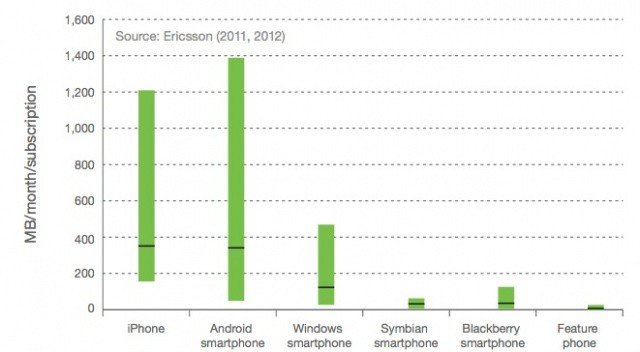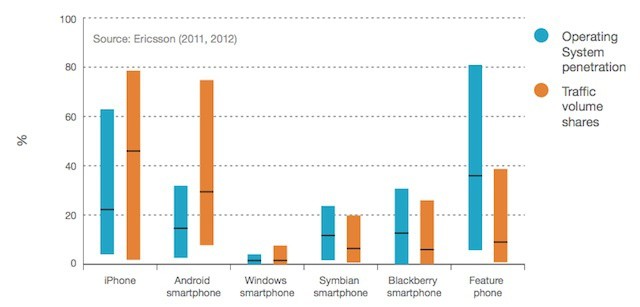It’s a pretty good bet that iPhones and iPads will be responsible for 3G/4G traffic spikes around the Moscone Center in San Francisco this week as Apple developers lucky enough to score a ticket attend WWDC. Beyond this week, however, it seems that iPhone users have a tendency to gobble up a large amount of data – more so than other platforms including Android.
On average, iPhone owners represent about 20% of smartphone customers for mobile carriers worldwide. You might expect that those customers would amount to around 20% of data usage. That isn’t the case as iPhone users account for an average 45% of carrier data traffic and data use by iPhone users is more consistent than data consumed by Android customers.
That news comes from Ericsson, the mobile hardware company that builds much of the infrastructure used by carriers around the world. The company bases the report on samples of data use from GSM carriers in North and South America, Europe, and Asia. While the iPhone averaged 45% of data use, Android devices as a whole represented an average of 30% of data use (and 15% of customers).
Ericsson notes that these averages aren’t uniform across all carriers that it sampled. Android data use varied widely from one carrier to the next. Some carrier networks saw and average of 50MB of data consumed by Android users in a single billing cycle while others saw traffic as high 1,400MB. Ericsson chalks the variation up to varied carrier data plan options and to the fragmentation of the Android market which includes a range of devices with different features and capabilities. While there is some variation in iPhone data use, it generally stays within a more consistent range than Android use.

Ericsson didn’t include a firm explanation for why Android use tends to vary more. It did suggest that on many carriers offering the iPhone, Android handsets are typically marketed as a lower-end and cheaper alternative to the iPhone. Another factor is that the iPhone typically represents the higher end of the device mix and attracts users willing to pay for more data (including overages) than lower-end Android handsets.
It’s worth pointing out that Ericsson’s data only accounts for GSM carriers like AT&T and doesn’t include information about CDMA carriers like Verizon and Sprint, both of which have been offering the iPhone for less than a year and a half.
Source: GigaOm
Image: Ericsson


